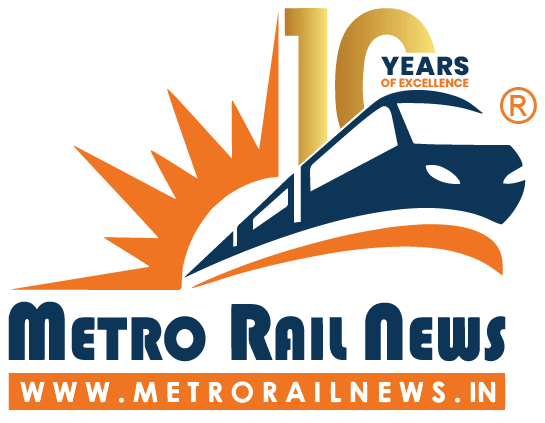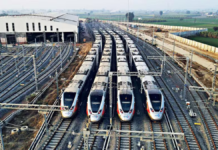Introduction
The Regional Rapid Transit System (RRTS) is a semi-high-speed rail system, designed to enhance connectivity across the National Capital Regions (NCR) of India. The RRTS allows for better commuter services, enhanced safety, and shorter travel time due to its high speed and frequency. The RRTS aims to provide an advanced and efficient alternative mode of transportation for intercity travel. Through RRTS, one can cover about 100 km in around 40-45 minutes.
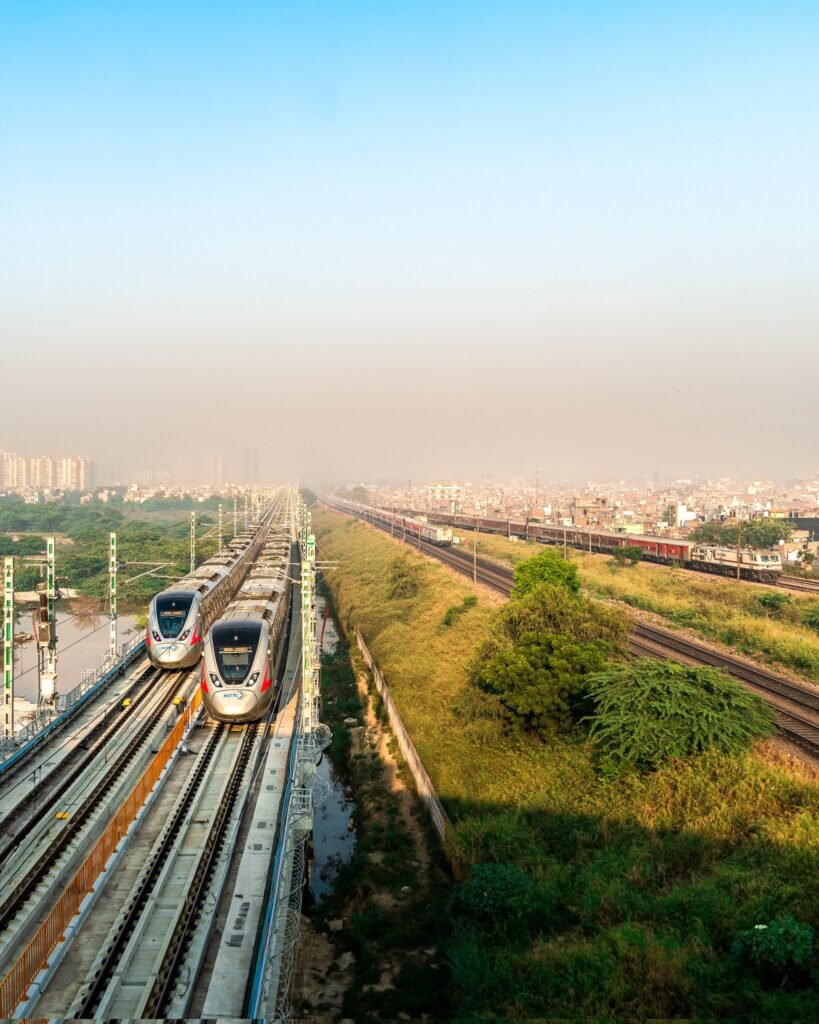
Phase 1 of the RRTS project covers 3 prioritised corridors.
- Delhi-Ghaziabad-Meerut
- Delhi-SNB-Alwar
- Delhi-Panipat
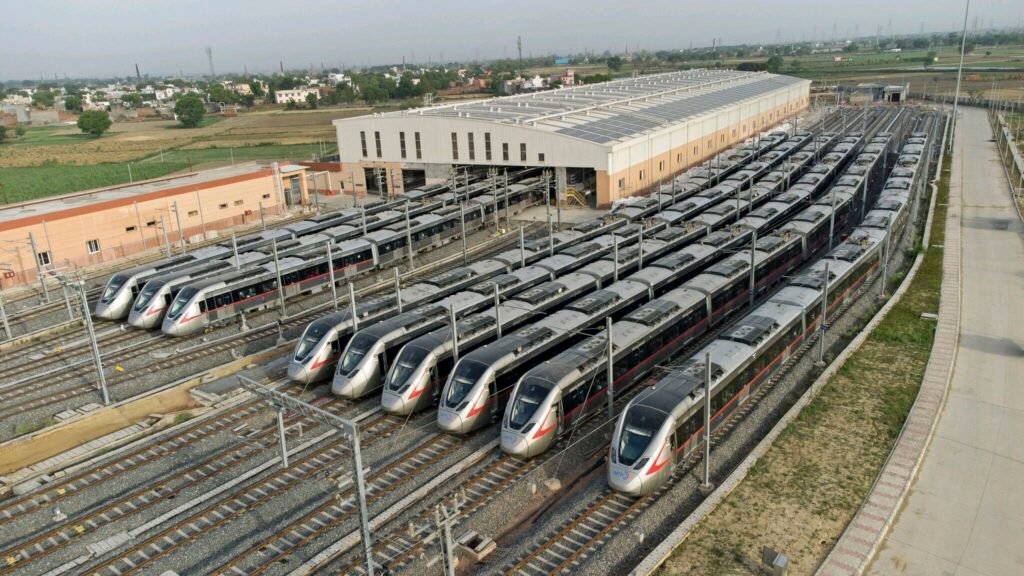
Delhi – SNB – Alwar RRTS
To improve connectivity and reduce travel time between Delhi and Alwar, the Delhi–Alwar Regional Rapid Transit System (RRTS) was proposed in 2005. This initiative came after the Planning Commission formed a task force to develop a multi-modal transit system for the National Capital Region (NCR). The task force identified three key corridors for implementation, including Delhi–Alwar, and assigned the Urban Mass Transit Company to conduct a feasibility study.
The National Capital Region Transport Corporation (NCRTC), a joint venture of the Government of India and the states of Haryana, Rajasthan, Uttar Pradesh, and Delhi, was tasked with developing the RRTS. The NCRTC is responsible for implementing the project.
The RRTS project aims to increase the overall productivity of the National Capital Region as the RRTS corridor will cross the urbanised and industrialised regions of Haryana and will link the Delhi airport with the RRTS network.
Overview
The Delhi- Alwar RRTS is a semi- high-speed rail line spanning 164 Km connecting Delhi – Gurgaon – Dharuhera – Rewari – SNB (Shahjahanpur – Neemrana – Behrod) – Alwar.
December 2018: The NCRTC’s board approved the Detailed Project Report (DPR) for the Delhi – SNB section of the Delhi- Alwar RRTS project.
February 2019: The Delhi – SNB section got the approval from Haryana Government.
June 2019: The Rajasthan Government approved the Delhi – SNB section of the Delhi- Alwar RRTS project.
Key Specification:
| Authorised Authority | National Capital Region Transport Corporation (NCRTC) |
| Speed and track | Average Speed: 100 kmphOperational Speed: 160 kmphMaximum Speed: 180 kmphTrack Gauge: Standard Gauge – 1435 mm |
| Rolling Stock: | Aerodynamic, 3.2 m wide x 22 m long, stainless steel/aluminium body. |
| Signalling: | European Train Control System (ETCS) Level 2 of ERTMS |
| Traction | 1 x 25 KV AC overhead catenary (OHE) |
| Classes: | Economy and Business (1 coach per train) |
Realignment in Routes of Delhi- Alwar RRTS
Originally, the Delhi-Alwar RRTS route was divided into three 3 phases spanning 199 km.
Phase 1: Delhi – SNB (106 km)
Phase 2 : SNB to Sotanala (35 km)
Phase 3: SNB to Alwar (58 km)
Earlier, the line was planned to navigate through old Gurgaon with stations at Udyog Vihar, Gurgaon Sector 17 and Rajiv Chowk.
| Update: In late 2023, the changes were made in alignment with the route. Now, the RRTS corridor will traverse through National Highway 48 (NH-48) with stations at Cyber City, IFFCO Chowk, Rajiv Chowk and Hero Honda Chowk. |
Route Information:
| Operational: 0 km | Under Construction: 0 km | Approved: 96 km | Proposed: 93 km |
Phase 1: Sarai Kale Khan – Gurgaon – Dharuhera
- Length: 70.72 km
Phase 2: Dharuhera – SNB
- Length: 36 km
Phase 3: SNB – Behror – Sotanala
- Length: 35 Km
Phase 4: SNB – Alwar
- Length: 58 Km
Type: Elevated, Underground & At-Grade
Depot: Dharuhera & Alwar
Total number of Stations: 22
Benefits of Delhi-Alwar RRTS
- Enhanced connectivity: The Delhi-Alwar RRTS will be able to enhance connectivity across the National Capital Regions (NCR). Through an RRTS, the travel time between Delhi and Alwar will be reduced from approximately 3.5 hours to just 104 minutes which will facilitate a quicker and more convenient journey for the commuters.
- Economic Growth: The RRTS will link the Delhi and outskirt regions of Alwar. This enhanced connectivity will attract more business setups, increasing the employment rate in these regions. This will boost the local economies, flourishing the economic growth of these regions.
- Infrastructure development: Through the RRTS project, the Delhi and outskirts regions of Alwar will witness major advancement in the infrastructure sector enhancing the economic development of these regions. Additionally, The Delhi-Alwar RRTS stations will be equipped with modern technologies like digital information systems, and enhanced security features providing passengers a more convenient and reliable mode of transport.
- Multi-Modal Hub: The Delhi Alwar RRTS corridor will be integrated with the other RRTS corridors. Additionally, it will provide connectivity with the Delhi metro system. For Instance, The cyber city Hub located in Gurgaon will link the RRTS station with the existing Rapid metro and the proposed Gurgaon metro line enhancing the connectivity.
Challenges in the Delhi-Alwar RRTS Project
- Environmental Concerns: The proposed route passes through sensitive ecological zones, including the Aravalli Biodiversity Park and ridge areas in South Delhi. A Supreme Court-appointed committee has permitted construction without tree felling; however, potential impacts on biodiversity and air quality remain critical issues.
- Land Acquisition Delays: The project requires significant land acquisition along the proposed route. Although land parcels have been identified, delays in land transfer to NCRTC could hinder progress. Timely acquisition and efficient collaboration with local authorities are necessary to maintain the construction schedule.
Conclusion
The Delhi-Alwar RRTS project aims to improve regional connectivity and commuter efficiency. Its success depends on addressing challenges such as environmental impacts, funding constraints, land acquisition issues, and construction complexities. Ensuring integration with existing transport networks and maintaining clear communication with stakeholders will be important for smooth implementation. By using technical solutions to manage disruptions and following timelines, the project can meet its goals of better mobility and transport infrastructure.
New Challenges of Sustainable Mobility
Introduction
Sustainable mobility encompasses transport systems which are environmentally friendly, economically viable and socially equitable. More than ever, with the rapid urbanization and critical problems of climate change, the need for sustainable mobility solutions is on the rise. Transportation is about 24-30% of global CO2 emissions.

Sustainable rail transit is a very effective and necessary mode of addressing urban mobility and climate change. Rail systems are among the most energy-efficient transport modes. However, their advantages have a new challenge that they have to address for their sustainability.
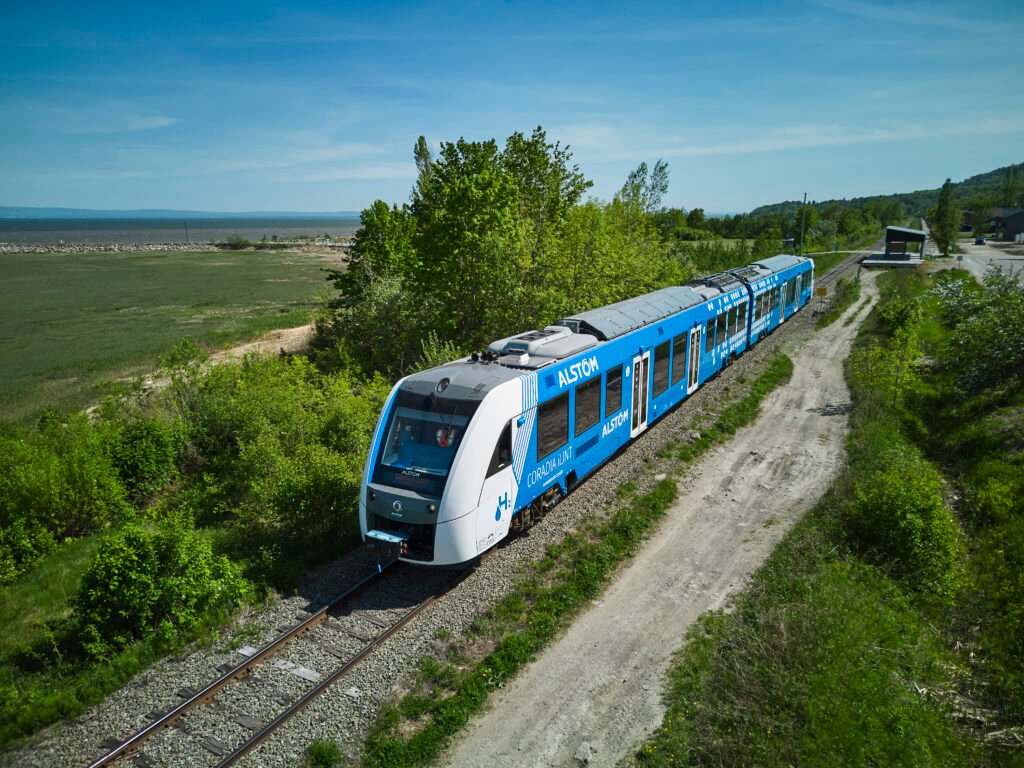
Contemporary Trends Affecting Sustainable Rail Transit
- Population Growth and Urbanization: As the cities become overcrowded with people, the demand for an improved public transportation network will also increase. Rail already has a good network, but it is getting stretched further as the city spreads to accommodate the growing population. Improvements and extensions to address increased passenger per unit service must be made in order to maintain the quality of service levels.
- Advances in Technology: With all the advancements, rail travel is at its best in terms of access and efficacy. Changing from diesel engines to electric and hydrogen engines has also achieved great environmental emission reductions. India’s first hydrogen-powered train is slated for a trial run in December 2024 between Jind and Sonipat railway stations in Haryana. Additionally, Integrating smart rail technologies, such as predictive maintenance and automated train operations into rail transit increases efficiency and safety.
- Changing Consumer Behavior: The consumers’ attitude is apparently changing- increasingly towards the means of transport. Commuters are opting for transport means that are sustainable in nature due to the spreading awareness about the environment, and thus more and more people in urban areas have started giving preference to rail rather than private vehicles. For Instance, Delhi Metro achieved the highest-ever passenger journey on 18 November 2024 with 78.67 lakh commuters reflecting that Metro is a preferred mode of travel by the residents.
Issues in Implementing a Sustainable Transport System
- Infrastructure Deficiencies: Indian Railways needs to modernise its ageing infrastructure to enable efficiency and safety. Poor investment in maintenance and upgrading takes a further toll on service disruptions, already raising costs of operation.
- Regulatory Barriers: Existing regulations may not adequately support the transition to sustainable rail systems. Challenges such as restrictive land-use policies and limited funding mechanisms often hinder the development and expansion of new rail lines.
- Financing and Investment Gaps: Transitioning towards sustainable rail transport systems would involve massive investments into infrastructure and technology. The PPP models in India have not been successful due to a lack of necessary support from the government.
Megatrends Shaping the Future Rail Transit
- Regulation for Sustainability: The government in India is implementing policies that support low-emissions public transport systems as a part of climate action strategies. India’s Metro Rail Policy 2017 is one such example which encourages sustainable urban mobility through the development of efficient and eco-friendly metro systems.
- Smart Devices and Infrastructure: Real-time information on train schedules and related conditions goes a long way to improve operational efficiency and passenger experience as the rail system incorporates smart technologies like IoT and CBTC.
- Connected Autonomous Vehicles: The development of autonomous trains and the implementation of the CBTC signalling system can improve safety and reduce delays. DMRC has currently instituted this type of operation on the Magenta Line within Delhi Metro with Unattended Train Operation (UTO) at present.
Strategies for Overcoming Challenges
Integrated Mobility Solutions: It is critical to encourage multi-modal transportation options that smoothly connect to other modes of public transportation to enhance accessibility and reduce dependency on private vehicles. For instance, the new Delhi-RRTS offers connectivity to the Delhi Metro.
- Innovative Financing Models: New funding models such as green bonds or public-private partnerships could be adopted to ensure financing for improvements in infrastructure with the least risks associated with investment.
Successful Stories in the Pursuit of Sustainability
- Electrification of Railway: Indian Railways has electrified 97% of its broad gauge. This development reinforced Indian Railways’ Ambitious 2030 target of becoming net zero carbon.
- Solar Infrastructure at RRTS stations: NCRTC has launched a solar policy which will encourage renewable energy use by producing more than 11 MW of solar power through the Delhi-Meerut RRTS corridor. As part of this initiative, solar panels have been installed at stations, depots, and other facilities. At present, solar plants at Sahibabad, Guldhar, Duhai, and Duhai Depot stations, Ghaziabad and Muradnagar receiving substations, and the RRTS depot together produce more than 3 MW of electricity.
Conclusion
The challenges involved in sustainable mobility, particularly in sustainable rail transit require immediate attention from stakeholders in the industry. There is a need to invest in advanced infrastructure, technology innovation, and public-private partnerships that would consolidate rail transport as a backbone for sustainable mobility. Challenges that need to be addressed to create efficient, environmentally friendly transportation systems that will cater to the needs of the growing urban population and serve the global sustainability goals.
